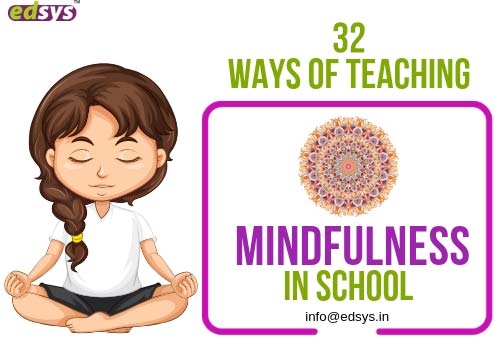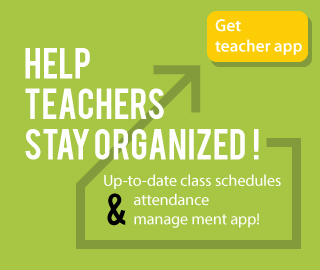Categories(658 Blogs)
Select Category
Watch Right Now
Teacher App - Class
Schedule & Attendance Management App
Parent App from Edsys

Best School Bus Tracking System

Cashless School - For Smart Schools of Tomorrow


32 Ways of Teaching Mindfulness in School

Education has to be about learning! Learning about professional topics. Learning about the world we live in. And learning skills to develop a career.
All these goals become a part of a child’s education, the moment he or she enters a classroom. However, there is one more aspect of learning, which is gaining more popularity day by day. And that is- learning mindfulness.
Due to the latest studies, teachers are now able to understand the importance of teaching mindfulness in schools.
To help out such great teachers, this article offers more than 31 ways to teach mindfulness in school.
1) Watching the glitter move
You can make a glitter container or purchase one. Such containers include colorful glitter mixed in a liquid. When you shake the container, the glitter takes some tip to stop moving. Watching this movement relaxes the mind of young kids.
2) Some time for the mind
You can decide mindfulness time durations for students. For instance, you can start every class by asking students to close their eyes and relax their mind. Or, you can turn the detention period into a period when students can meditate. That is exactly what the Robert W. Coleman Elementary School conducts in the location Baltimore Maryland.
The inclusion of meditation has offered outstanding results at the school. So, you have a proven mindfulness exercise to apply.
3) Utilize finger breathing
Finger breathing offers a visual method of focusing on breathing. Students can use their fingers to breath slowly and focus on their breathing one after another.
4) Introduce books on mindfulness
Students should understand the value of mindfulness in their lives. Which is why you should include books on mindfulness in the curriculum at your school.
5) Designate a mindfulness day of every week
Every week, you can decide a day dedicated to mindfulness. On this day, teachers are supposed to talk about wellness and conduct breathing exercises and meditation to help kids improve.
Know More: How to Assign Homeworks For Effective Results?
6) Improve attentive listening with chimes
Ring the soothing sound of chime and ask students to raise a hand after they stop hearing the sound. This allows kids to listen to sounds attentively, which improves concentration.
7) Conduct an exercise of body scan
Prepare a yoga-like environment and ask students to lay down, looking at the ceiling. Then, every student has to scan his or her own body with their mind. The scanning can begin from the feet and move up towards the head. Ask students to focus on each body part and relax it.
8) A mindful walk
Create a safe outdoor environment for kids to walk. Designate an area of 5-6 steps for every student. Ask them to walk without their shoes and explain how their feet feel.
9) Finding the internal rhythm
There are several body areas where we can find our pulse. These areas are the heart, the wrist, and the neck area under the jaw. You can ask students to put their hand or fingers to find their own pulse. Let them close their eyes and focus on the beats. Ask them to jump thrice and check the pulse again.
10) Breathing buddy
Give a stuffed toy to every kid in the classroom. Provide yoga-like arrangement so they can lay down, looking up at the ceiling. Ask them to put their toy on their belly. Then, give them a task to breathe slowly for 2 minutes, while focusing on the movement of their toy as they breathe.
11) Smell and tell
This exercise requires good fragrance such as lavender, orange peel or a flower. Ask students to shut their eyes and concentrate on the fragrance. This will help in releasing anxiety.
12) Touch and tell
After the “smell and tell”, you can utilize the exercise of touch and tell. Include a variety of objects such as feathers, ball, stone, and a soft toy. Students are supposed to keep their eyes closed and touch each object one by one and describe them to their partner.
13) Having a mindful snack
Encourage students to feel the touch of their food, smell the aroma and slowly chew every bite. Notice every aspect of eating a snack. Ask them to chew every bite 30 times slowly before they swallow.
14) Responsible break
Give each student a bell and allow them two rings to stop an ongoing class between 50 minutes. Every time a student pushes the ring, everyone has to stand up, stretch and sit back silently again for 20 seconds. Then, the class begins again.
15) Controlled break
If responsible breaks don’t work, you can take control over the breaks during a class. So, the teacher decides when students should stand up, stretch and sit down to stay silent for 20 seconds. Ask students what are they thinking about right at that moment and why.
16) Mindful end of a chapter
At the end of a chapter or a class, let students breathe slowly and focus silently. Ask them to go through what they have just learned in their mind.
17) Tell a story
Stories during a class help students tap into their deeper levels of concentration and imagination. Including one or two stories will improve knowledge retention and improve the ability to understand concepts in students.
18) Create active classes
Teenagers are quite good at talking, but they hide away from indulging in activities. You need to make your lectures full of activities to help them come out of their shyness.
19) Make mindfulness meaningful
Every student wants to ask why you want to teach him or her mindfulness. So, create a link between mindfulness and how they can improve their daily lives with it. This will help students engage more.
20) Shark fin
Students can make a half “Namaste” pose with one hand and put it right in the middle of their forehead. Closing the eyes, they need to say out loud “shhh”, while sliding their hand down the face. Then, stay silent for 10 seconds, and then, breathe slowly for 2 minutes.
21) Breathing with colors
Ask every student to choose a color of happiness and a color of sadness. Similarly, designate colors for anxiety, calmness, nervousness and other emotions. Now, ask students to think of the colors that make them feel happy and focus on slow breathing.
You can also tell students to inhale while thinking a happy color and exhale while thinking about a sad color.
22) The Spiderman exercise
Spiderman has his 6th sense and you can help students find their sixth sense too. Ask students to feel as if they are Spiderman. Then, ask them to use their superpowers of hearing, seeing, tasting, feeling and smelling. Do this exercise for 2 to 4 minutes.
23) Gratitude journal
Indulge every student in creating a gratitude journal. In this journal, they all need to write about their experiences of that day. You can help by asking about the activities they, the person they enjoyed talking to, and a lesson they learned.
24) Mindful safari
In a large landscape or garden, allow students to indulge in the search for natural items. Ask them to explore nature with all five senses.
25) Countdown of senses
Ask students to think about 5 items they are able to see, 4 items they are able to touch, 3 sounds they are able to hear, 2 things they are able to smell and 1 thing they are able to taste.
Know More: 27 Facts About Pollution For Kids.
26) The weather report
Take students outside and ask them all to close their eyes. Now, encourage them to focus on the weather conditions they can feel using their 4 senses. They need to make their personal weather report and show it to you.
27) Indulge in drawings
Give all the freedom to students to color as per their creativity. They can use any color they like, but the catch is that they should be able to explain why they used each and every color.
28) Write a superhero story
Ask students to create their own superhero with special superpowers. They need to write 5 to 10 lines story and explain why everyone needs their superhero.
29) Thin ice walk
This is an outdoor activity. Students need to pretend that there is nothing but a thin layer of ice beneath their feet. So, they have to take each and every step very carefully and slowly.
30) Smell the imaginary pizza
Practice this with students who get anxious or angry very easily. Ask them to breathe in as if they are smelling a pizza slice.
31) Taste and tell
Blindfolded students taste food items and keep it for 1 to 2 minutes in their mouths to explore the feel of that food item.
32) Drawing an object
Give common objects to observe for about 2 minutes. Then, take the object away and ask students to draw a picture using their mental image of that object.
Use all the given ideas to encourage mindfulness in your students. This way, you can prepare students to grow up to become a confident person with confident self-awareness and the awareness of their own surroundings.
Recent Blogs
Our Educational Services
Popular Blogs
Subscribe

SUBSCRIBE TO OUR NEWSLETTER
Sign Up and Recieve the Latest News
Don’t Worry, We Don’t SpamExplore Our Extensive Researched Educational App Directory
Visit Now

















